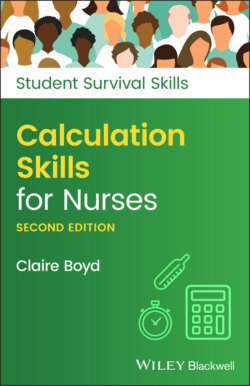Читать книгу Calculation Skills for Nurses - Claire Boyd - Страница 7
ОглавлениеIntroduction
Hello, my name is Claire.
This is the second edition of a book written with the assistance of nursing students, informing me of what they wanted included in a book to help them with their nursing calculations.
I have been a Practice Development Trainer in a large NHS Trust for many years and a nurse for over 30 years. It has been my pleasure to teach literally thousands of students in a variety of healthcare related subjects including my favourite subject – nursing calculations. I know that not all of you share my passion, some have even told me that they feel physically sick at the mention of the word ‘mathematics’ and have expressed a fear of making a calculations error in drug administration and also taking a calculations test. Fear not, I will take you by the hand and lead you through the streets of London (opps! Sorry that was a song) and lead you through some basic maths revision, leading on to more complex calculations and on to those dreaded maths tests. I think I am best placed to prepare you for the tests as I actually write many of them!
Nursing has certainly evolved since the first addition of this book, not least the development of the Nursing Associate. You will see many Glossary terms, such as the following one explaining the role of these highly skilled healthcare professionals.
Nursing Associate
The Nursing Associate is a member of the multidisciplinary nursing team in England that aims to bridge the gap between Health Care Assistants (HCA’s) and Registered Nurses (RN’s). Nursing Associates have been accepted onto the Nursing and Midwifery (NMC) register in England since January 2019.
You will also see directions to websites to assist the reader, at the bottom of the chapter pages, like these ones:
USEFUL WEB RESOURCES:
www.nmc.org.uk
www.skillsforhealth.org.uk
This book came into fruition by listening to student nurses – their wants and needs. This second edition has included a wider audience Nursing Associates, Overseas nurses and many more, and I have been grateful for the reviews from students and other readers who have given me suggestions for improvements for the new edition:
1 More practice activities – tick
2 Title change for more inclusivity – tick
3 More test questions – tick
4 More on looking at budgets and interpreting data – tick
5 Pointers to websites – tick
There are test questions for student nurses, newly qualified nurses, nurse associates, nursing assistants, paediatric nurses, midwives, mental health nurses, learning disabilities nurses, and the nurse prescriber (NMP).
Nurse Prescriber
Post graduate nurses who have been licensed to issue medications to patients without a doctor being present or assessing the patient. Also known as Non‐Medical Prescribing Nurse (NMP)
There are also many more exercises and activities to get stuck into, and examples whereby you will see a box like this:
Let me show you an example…
1 If you buy a rooster for the purpose of laying eggs and you expect to get 3 eggs each day for breakfast, how many eggs will you have after three weeks?ANSWER: 3 × 7 = 213 × 7 = 213 × 7 = 21 TOTAL = 63 EggsWRONG!Roosters are male chickens and don’t lay eggs! D’oh!
OK, so that was a bit of fun! Don’t worry if you got fooled by this trick question, I did too when I first saw it. I just wanted to show you that we all make mistakes, but if we take our time, and work through any question methodically, we can work it out. After all, the majority of healthcare questions just rely on your ability to add, subtract, divide or multiply – yes, it really is that simple!
This book is divided into four parts:
Part 1: Diagnosis – includes assessing your own ability and basic revision. You can miss out these chapters if you feel you don’t need to work through them but this will give you a good grounding in basic maths, preparing you for the more complex questions.
Part 2: Understanding nursing calculations – this will show you what you need to know in the clinical area, such as working out drug dosages.
Part 3: Putting it all into practice – this will show you where the calculations we have worked through are applied in practice. It will show us that mathematics is used in many different areas in health care, including undertaking sample test questions, and working with budgets.
Part 4: Testing your knowledge and understanding – this is where we can monitor our increased abilities and showing us our progress.
I will show you how I approach maths problems: I believe firmly in using formulas for working out drug dosages, but I am aware that an understanding of how these formulas work must first be established, and a rough estimate of the correct answer should always be at the back of our minds. It is for this reason that I have produced the formulas in a handy format on the inside back cover for you to photocopy and laminate (for infection control, to be wiped clean) and keep in your pocket.
This book has been related to the NMC Standards for nursing and midwifery education (May 2018), Proficiency for registered nurses (May 2018), Proficiency for Nursing Associates (October 2018), Pre‐registration Nursing Associate programme (October 2018) and The Code – Professional Standards for practice and behaviour for nurses, midwives and nursing associates (October 2018) and the NMC Essential Skills Clusters. However, this book is designed to assist anyone working in the healthcare setting requiring mathematical assistance.
In short, this book is designed to instil confidence and competence in the area of calculations to healthcare professionals. It is designed to be used as a building block, a platform for the rest of your healthcare career.
